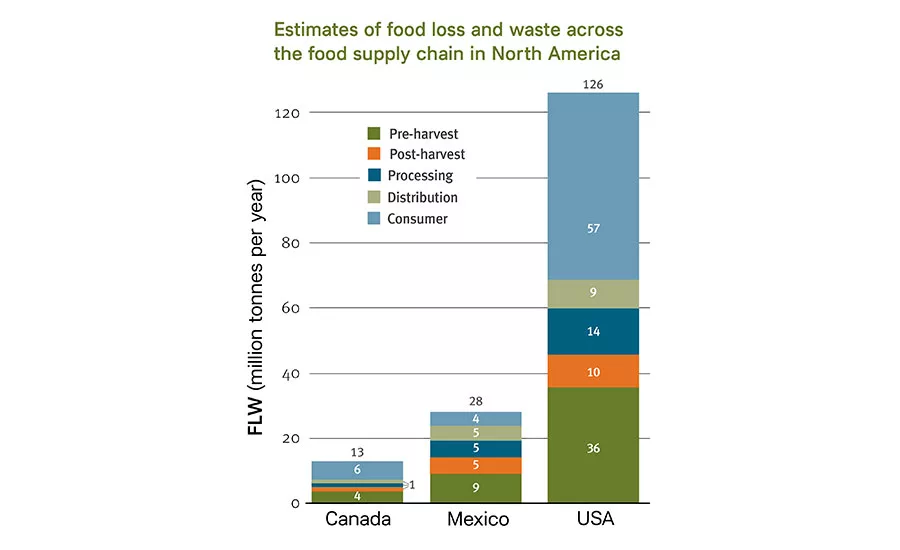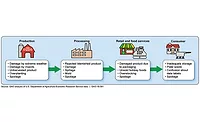Manufacturing News
Food waste in the supply chain
The environmental and socioeconomic impacts of food waste across the food supply chain are significant

Every year, approximately 1.3 billion tons of food are lost or wasted around the world—an amount that could feed almost half of the world’s population, according to a Kellogg spokesperson.
In North America, approximately 168 million tonnes of food are wasted every year—with Americans wasting 915 lbs. per person; Canadians, 873 lbs. per capita; and Mexicans, 549 lbs. per individual—according to a new study from The Commission for Environmental Cooperation (CEC) in Montréal.
The CEC report, “Characterization and Management of Food Loss and Waste in North America,” attributes the primary causes of food loss and waste (FLW) to overproduction by processors, wholesalers and retailers; product damage; lack of cold chain infrastructure (refrigeration during transportation and storage); rigid food grading specifications; varying customer demand; and market fluctuations.
Key players, such as farmers, processors, distributors, retailers, food rescue organizations and other service providers, can influence how products are moved along the supply chain.
The environmental and socioeconomic impacts of FLW across the food supply chain are significant. Using multiple recent studies, including FAO’s Food Wastage Footprint (FAO 2013), CEC’s research team derived estimates of the impacts of FLW for North America per year. A few examples include:
- 193 million tonnes of greenhouse gas (GHG) emissions or equivalent CO2 for lifecycle of landfilled FLW; this is equal to 41 million cars being driven continuously for a year.
- 17.6 billion cubic meters of water used
- 22.1 million hectares (54.6 million acres) of cropland used
- 3.94 million tonnes of fertilizer used
- 38.6 million cubic meters of space used in landfill
- $1,867 million spent in tipping fees
- $278 billion in market value of FLW lost
- 217 trillion kilocalories in potential energy lost.
While the report suggests that foodservice establishments and consumers can reduce portion sizes to cut down on FLW, other important methods to reduce FLW can be applied to various points in the supply chain. For example, these include methods of source reduction such as:
- Increasing marketability of produce
- Standardizing date labels
- Packaging adjustments
- Improving cold chain management
- Value-added processing.
Another key area to reduce FLW is in food rescue and recovery. Some ways to do this include increasing the rescue of healthy food, improving storage and transportation, providing financial incentives for food donation and liability protection for food donors, creating online food rescue platforms and using the food to feed animals.
The study also suggests that measuring, tracking and reporting approaches can be taken to reduce FLW. These can be accomplished by performing a waste composition analysis, keeping diaries, doing surveys and using models and proxy data extrapolation methods.
The report finds that there are promising opportunities to develop strategies and initiatives to address FLW in North America. Some opportunities involve cross-cutting with all relevant stakeholder organizations—industrial, commercial and institutional (ICI)—while others specifically address source reduction of food waste; food rescue and recovery; and/or measuring, tracking and reporting performance.
Cross-cutting can include several activities, such as developing FLW policies, fostering multi-stakeholder collaboration, creating a voluntary ICI initiative and strengthening regional collaboration. Methods to improve source reduction include standardizing data labels, updating food grading techniques, improving cold chain management and expanding value-added processing and packaging innovation.
Although this report doesn’t deal with FLW at the pre-harvest and consumer levels, it does list causes for FLW in the supply chain, including post harvest, processing, distribution, retail and foodservice.
In processing, several issues cause waste. Some include inadequate infrastructure and machinery, inefficient systems design, damage during production, inaccurate supply-and-demand forecasting, contamination, trimming and cutting problems, other supply/demand issues, inconsistent and confusing date labels, inconsistency in quality of ingredients, food safety issues, production line changes, cold chain problems and facility employee behavior.
The report suggests that those who can address these issues in one way or another to improve FLW in the processing area include facility managers and employees, retailers, distributors, service providers (equipment, process engineers), food rescue organizations and various levels of government.
For more information or to download the study, visit http://www3.cec.org/fw/organic-waste-reports.
Looking for a reprint of this article?
From high-res PDFs to custom plaques, order your copy today!







